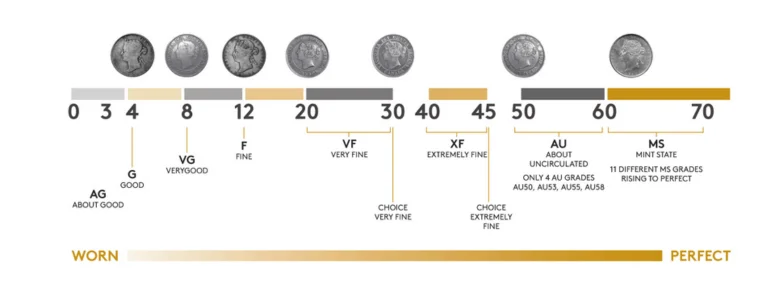Do you have a jar of old coins or inherited Coins sitting around? Ever wondered if any of them could be valuable? Identifying valuable coins can seem complex. This guide simplifies the process. You will learn key factors that determine a coin’s worth. Discover how to spot potential treasures in your collection.
Key Factors in Coin Valuation
Several factors affect a coin’s value. Understanding these helps you identify valuable pieces.
- Rarity: A rare coin is often valuable. Limited mintages or errors increase rarity. Check mintage figures for specific years and mint marks.
- Condition: A coin’s condition significantly impacts its value. Coins are graded on a scale. This scale typically ranges from Poor to Mint State (MS). Higher grades mean better condition and higher value.
- Historical Significance: Coins linked to significant historical events can be valuable. Research the history behind your coins.
- Metal Content: Coins made of precious metals like gold or silver have intrinsic value. Track current metal prices to estimate value.
- Errors: Minting errors can create unique and valuable coins. Look for double dies, off-center strikes, or missing elements.
Essential Tools for Coin Identification
Having the right tools makes coin identification easier. Here are some basics:
- Magnifying Glass: A magnifying glass helps you examine fine details. Look for wear, errors, and mint marks.
- Coin Catalog: A current coin catalog provides pricing information. It offers details on different coin types.
- Scale: A digital scale measures a coin’s weight accurately. This is important for identifying metal content.
- Calipers: Calipers measure a coin’s diameter and thickness. These measurements help verify authenticity.
- Soft Cloth: Use a soft cloth to handle coins carefully. Avoid scratching or damaging the surface.
Steps to Identify Valuable Coins
Follow these steps to identify potentially valuable coins.
- Gather Your Coins: Collect all the coins you want to evaluate. Organize them by type and denomination.
- Check the Date and Mint Mark: Look at the coin’s date and mint mark. Key dates and rare mint marks can significantly increase value.
- For example, the 1909-S VDB Lincoln cent is highly sought after. The “S” indicates it was minted in San Francisco.
- Assess the Condition: Examine the coin’s condition closely. Look for wear, scratches, and damage. Use a coin grading guide to estimate its grade.
- Identify Potential Errors: Check for any minting errors. Double dies, off-center strikes, and other errors can add value.
- Research the Coin: Use a coin catalog or online resources to research the coin. Find information on mintage figures, values, and historical significance.
- Consult an Expert: If you find a potentially valuable coin, consult a professional coin appraiser. They can provide an accurate assessment. They offer this service.
Spotting Key Dates and Mint Marks
Certain dates and mint marks are more valuable than others. Here’s what to look for:
- 1909-S VDB Lincoln Cent: This coin is rare due to its low mintage and the initials “VDB” on the reverse.
- 1937-D Buffalo Nickel: Look for a “D” mint mark under the buffalo. Some coins have a doubled die on the obverse.
- 1916-D Mercury Dime: This dime is valuable due to its low mintage in Denver.
- 1932-D and 1932-S Washington Quarters: These quarters have low mintage figures. Check for the “D” or “S” mint mark.
- 1893-S Morgan Dollar: This silver dollar is highly prized due to its extremely low mintage.
Understanding Coin Grading
Coin grading is a standardized system for assessing a coin’s condition. The Sheldon Scale is commonly used. It ranges from 1 (Poor) to 70 (Perfect Mint State).
- Poor (P-1): The coin is heavily worn. Details are barely visible.
- Fair (FR-2): The coin is worn. Some details are visible.
- Good (G-4): The coin shows significant wear. Major features are visible.
- Very Good (VG-8): The coin shows moderate wear. Details are clear.
- Fine (F-12): The coin shows moderate wear. All features are visible.
- Very Fine (VF-20): The coin shows light wear. Details are sharp.
- Extremely Fine (EF-40): The coin shows very light wear. Details are crisp.
- About Uncirculated (AU-50): The coin shows slight traces of wear. Most details are sharp.
- Mint State (MS-60 to MS-70): The coin is uncirculated. It shows no wear. MS-70 is a perfect coin.

Common Minting Errors to Look For
Minting errors can make a coin valuable. Here are some common errors:
- Double Die: The coin has doubled or distorted features.
- Off-Center Strike: The coin’s design is not centered on the planchet.
- Broadstrike: The coin lacks a collar. This causes it to spread out.
- Clipping: Part of the planchet is missing. This creates a crescent-shaped defect.
- Lamination Error: Layers of metal peel off the coin’s surface.
Where to Find Coin Values
Selling Your Valuable Coins
If you have valuable coins, consider these options for selling:
- Coin Shops: Local coin shops like Mountain View US and Foreign Coins in the Bay Area and San Jose buy coins. They can offer fair prices.
- Auctions: Auction houses sell rare coins. They can reach a wide audience.
- Online Marketplaces: Websites like eBay allow you to sell coins directly.
- Coin Shows: Coin shows bring buyers and sellers together. They offer opportunities to network.
Take the First Step Toward Discovering Your Coin’s Value
Your coin collection could hold hidden gems waiting to be uncovered. With the tips and tools shared in this guide, you’re now equipped to identify valuable coins, understand their worth, and explore opportunities to sell them. Whether you’re a beginner or an experienced collector, every coin has a story—and potentially, significant value.
If you’re looking for expert guidance or need a professional appraisal, Mountain View US and Foreign Coins is here to help. Text photos of your coins to (415) 952-6467 for a free consultation and appraisal. Start your journey today and unlock the potential of your collection!

